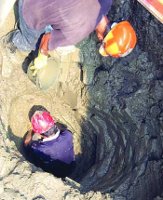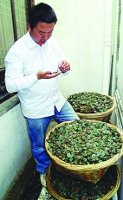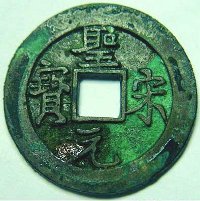
Coin Stash Found in Well
Approximately 200,000 ancient coins dating from the Northern Song Dynasty (960-1127 AD) were recently unearthed from an old well in eastern China.
The Xinhua News Agency reported on June 4, 2011 that a construction crew building a road in the city of Suzhou in Jiangsu Province uncovered the old well on June 1st. The opening to the well was located 4-5 meters below the surface.
Digging stopped immediately after the well was discovered and the construction crew quickly determined that this well was different from those usually encountered. Instead of being round, the opening was eight-sided.
Digging a little deeper, the crew was surprised to find a large quantity of ancient Chinese coins inside the well.

Archaeologist Examines Coins
The Suzhou Archaeology Research Bureau was immediately notified and eight experts were sent to the site.
The archaeologists removed more than 80 bags of coins. Each bag weighed more than 50 kilograms so the total weight of the coins was about 4 tonnes (metric tons).
There were more than 200,000 coins dating from the Northern Song Dynasty.
Mr. Zhang Tiejun (张铁军), the assistant to the president of the bureau, described the find as “large”. He said the coins were in two layers. The top layer was neatly arranged while the lower layer was fairly disorganized.
The upper layer included larger coins such as chong ning zhong bao (崇宁重宝 1102-1106 AD) while the lower layer had smaller coins such as yuan feng tong bao (元丰通宝 1078-1085 AD) and shao sheng yuan bao (绍圣元宝 1094-1097 AD).
According to Mr. Zhang, the inscriptions on the coins indicated that they were from the middle to late Northern Song Dynasty (960-1127 AD).

Sheng Song Yuan Bao Silver Coin
Mr. Zhang was particularly excited about one coin in particular. The cache included a coin with the inscription sheng song yuan bao (圣宋元宝) which was cast during the first year (1101 AD) of the Jing Guo (靖国) reign of Emperor Hui Zong (徽宗). The coin is made of silver instead of bronze and for this reason is considered very rare and valuable.
Mr. Zhang said it would be difficult to say how much the total cache was worth.
As to the question of why such a large quantity of coins was stored in a well, Mr. Zhang said that Suzhou’s economy was fairly well developed during this period of the Northern Song Dynasty. Most likely, a wealthy businessman was suddenly faced with the chaos associated with war and decided it best to hide his money.
Mr. Zhang said he did not think the money came from a “rich and influential family”. Very wealthy families would usually have gold and silver instead of bronze coins and they would not likely keep these valuables at home.
Also, the type of jugs commonly used to fetch water were found at the bottom of the well. This indicates that the structure had been a functioning water well and had not been built specifically to store money.
Mr. Zhang conjectured that the combination of the haphazard placement of the coins, plus the fact that the structure itself had functioned as a well, meant that someone probably found himself caught in a war zone and needed to immediately bury his money for safekeeping.
The article concluded with Mr. Zhang stating that his team had researched the history of the area and discovered an interesting fact. At that time period, the area had been the scene of a fierce battle between the Song army and the army of the Jurchens. The Song army was led by Han Shizhong (韩世忠), one of the most famous generals of the Song Dynasty. His wife *Liang Hongyu (梁红玉), who was a famous warrior in her own right, also participated in the battle.
*Liang Hongyu is credited with implementing new war tactics such as the use of drums to relay orders to the troops at the battle of Gold Mountain. For more about Liang Hongyu and Gold Mountain, please see Chinese Paper Money.